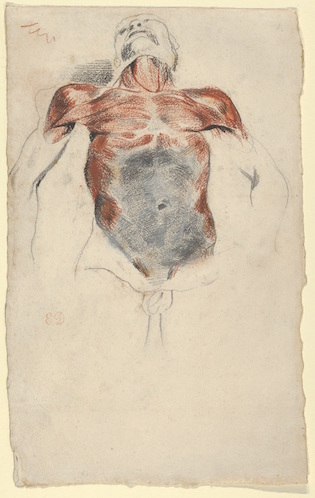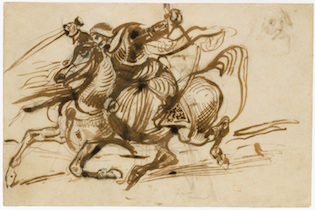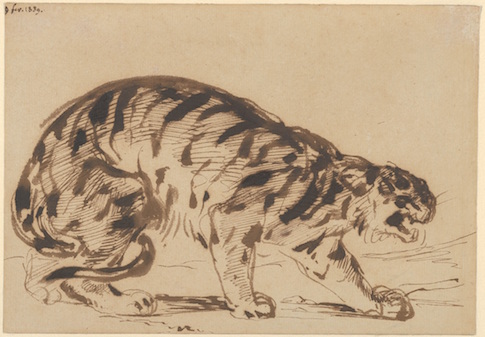Eugène Delacroix bucked whenever he was labeled a romanticist. "I am a pure classicist," he insisted. That could come as a surprise: He is often called the leader of the romanticist genre that spread through the first half of the 19th century. While both movements celebrate the past, romanticism is unbridled while classicism is reserved. The Metropolitan Museum of Art's exhibit Devotion to Drawing: The Karen B. Cohen Collection of Eugène Delacroix, a preview for a far larger retrospective opening Sept. 17, shows that Delacroix managed to embody both. His commitment to "pure" classicism led to a romanticist style, however unintentional.
Delacroix's friends called him a realist—the opposite of a romanticist—and the artist would agree. ''There are horrid things in this world," Delacroix told George Sand, "but, after all, what shall we find beyond it? Night, dreadful night." He clearly wasn't an optimist.
Delacroix trudged the well-worn path of academic classicism because he knew it would make him a better artist. In the small, three-room show, you will see over 100 drawings, from early sketches of his time at the Ecole des Beaux-Arts, which he was admitted into in 1816 at 18 years old, to compositions for his most famous works, such as The Death of Sardanapalus and The Sultan of Morocco and his Entourage.
Classical academic technique could be considered dry because there is no coloring out of the lines. The widely used practice (still standing today) consisted of three steps outlined in a drawing manual by Delacroix's friend Elisabeth Cavé: tracing, freehand copying, and drawing from memory. "By means of a tracing of the object," Delacroix wrote of her manual, "her pupil cannot help acquiring a knowledge of foreshortenings, that stumbling block in all kinds of drawing."
He considered copying or tracing crucial to the development of an original style. Delacroix was not the only one who thought so, as he pointed out in his journal: "Raphael, the greatest of all painters, was also the most diligent of copyists." While many of his romantic contemporaries skipped copying and stuck to creating original content, Delacroix thought copying was key to "the education of most of the great masters."
Delacroix's devotion to creating a correct copy is best seen in his reproduction of Raphael's Battle Scene with a Prisoner Being Bound. The museum offers Delacroix's 1823 drawing next to a large, battered book holding the

engraving, the sort of book Delacroix would rent from the Bibliotheque Nationale. Looking at the two side by side, you can see no mistake. Each line is the same, the composition equally engaging. Delacroix also homed in on Rubens, the artist he wrote the most about in his journal, to make drawings after engravings of the Flemish master's paintings.
Another academic practice of the time was not for the faint of heart. As a student, Delacroix practiced écorché drawings: sketches of cadavers. It was considered a normal practice in the 1800s to draw the dead, particularly those flayed, so artists could see beneath the flesh and distinguish proportions of the body and its interiors. Delacroix highlights his drawings of the dead with red crayon and sinuous lines that sculpt the arm or chest, even showing the dead face with mouth agape and eyes lifeless.
These exercises were invaluable: Delacroix developed a sense of the body's movement, in death and life, and would use the subjects in preparatory sketches for his popular paintings, such as Liberty Leading the People (1830) and The Two Foscari (1855). He learned through academic, classical practice how to compose a composition that could be imbued with gravity, sending bodies tumbling to the floor or held up by a weeping mother, or charging forward with force. The exhibit definitely caters to art history buffs, who will be particularly interested in compositions for The Education of Achilles (1845) and The Tribute Money (1843), which would later develop into his works for the Theology Cupula in the Deputies Library at the Palais Bourbon.
Delacroix had an enthusiasm for drawing animals, and this passion produced the most rewarding drawings in the exhibit. "What an immense variety of animals and species of different shapes and functions!" Delacroix exclaimed. Here we see Delacroix's unique style begin to emerge. His sketches of lions, tigers, and horses reveal Delacroix's rapid and deliberate movement of hand. He captured the slope of the horse's neck in The Giaour on Horseback (1824-26) as it tugs at its bit, and risen hooves deliver a rumbling sense of action as if it will canter off the page. The rounded lines of Thrown Horseman (1862) perfectly express a sway of movement, while the horse's head is flung toward its deposited rider.
The Crouching Tiger (1839), perhaps the most beautiful fully realized drawing in the exhibit, came from Delacroix's many visits to the zoo. It was in these trips that Delacroix revealed the romanticist hidden inside his classicist shell. "How necessary it is," he wrote, "to give oneself a shake from time to time; to stick one's head out of doors and try to read from the book of life that has nothing in common with cities and the works of man." Like most curmudgeons, he was softer than he liked people to believe.

1824–26 / Metropolitan Museum of Art
But there are also works of the imagination. Of course, Delacroix never witnessed animals fight as they do in Studies of a Rearing Horse Attacked by a Lion and a Lion Wrestling with a Serpent (1830). Yet after studying at length the movements and body of the horse he could satisfactorily render the brutal scenes with curling ink lines. Delacroix was telling stories with his art—a romanticist practice brought to life by years of classicist study.
Romanticists did not see the world realistically, Delacroix thought. He compared the works of Schubert, or "dreamers" like Chateaubriand, to a walk in the countryside. "I feel a continual longing to plunge into it," he wrote, "to be a bird, a tree whose roots are steeped in it, to be anything except an unhappy, sick, bored old man."
The self-proclaimed classicist was therefore surprised when his friend, art critic, and poet (and later Delacroix's biographer) Charles Baudelaire, compared him to the romanticist Edgar Allen Poe. Delacroix was not a bohemian drunk like Poe. His hopper was full of state commissions since his early 20s, and he attended balls frothing with French elites.
But it was his raw and gloomy revelations that gave his paintings and drawings a romanticist quality. Audiences are intrigued by stories of darkness, whether it be in Poe's The House of Usher or Delacroix's The Death of Sarandapalus. Baudelaire dubbed Delacroix the "leader of the modern school," and he wasn't the only one who thought so.
The later masters who followed Delacroix worshiped him: Claude Monet would creep by Delacroix's studio in Paris, hoping to catch a glimpse of him. Paul Cézanne said, "All this luminous color—it seems to me that it enters the eye like a glass of wine running into your gullet and it makes you drunk straight away." Odilon Redon, whose love of Delacroix bordered on obsession, confessed he followed the artist at a distance after an 1859 ball, and said his "fine-boned and aristocratic" idol walked the streets of Paris alone for hours. "He was as beautiful as a tiger, the same pride, the same finesse, the same strength," Redon reflected. Pablo Picasso, whose famous pride rarely admitted another artist's worth, said, "That bastard. He's really good."
Only perhaps 20 people strolled through the exhibit during my two hours spent there on a Saturday afternoon. But it is rewarding to see these drawings stand on their own before they are inevitably overwhelmed by his paintings and their roar of powerful color. The drawings, after all, are not only the bones that would lead to those famous works: They show his path from student to master. The Met was right to preview the drawings before the full retrospective. They deserve their own time for contemplation and respect.
